Choosing the right cookware can be tricky. The following is a handy guide to choosing the right cookware material for cooking, including searing, roasting, frying, braising, and more, along with how to stock your kitchen.
Every form of cookware has its pros and cons. In addition, various cooking processes are better suited to specific materials.
The best saute pan, for example, will be extremely sensitive to temperature changes, whereas the greatest braising pot will hold and manage heat regardless of temperature variations. Your goal should be to get the best elements for the items you’ll be cooking.
This article will explain the various materials used in most cookware and how they might benefit you. After that, you just have to choose which is best for you.
Hopefully, this quick reference to the benefits and cons of each material will be helpful. You can also see our cookware buying guide in depth.
Best Cookware Materials
Many different materials are used to make cookware. Understanding the difference can help you make the right decision for your needs. Below are the most common cookware materials and their pros and cons. Throughout the guide, We’ll explain different types of cookware materials in further depth.
Cast Iron
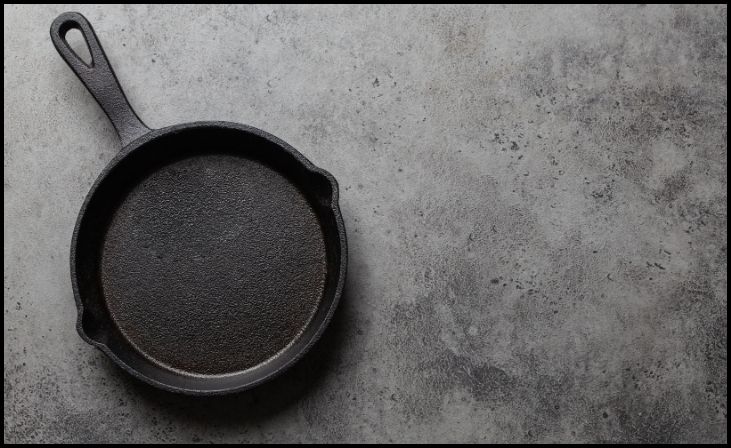
Cast iron is an old-fashioned cooking material that’s porous and gives a lot of flavors when adequately cared for. It’s virtually unbreakable.
Cast iron cookware ranges in price from low to moderate. It is one of the most flexible cooking materials. It takes a lot of time to heat up, but it stays warm for a long time once it does. It’s ideal for deep frying and slow cooking because of this. You can use it in the oven, on the grill, and on top of the stove. However, cast iron has the disadvantage of rusting, staining, and pitting when exposed to air, moisture, and certain foods.
When cooking with cast iron, it’s crucial to note that you’ll need to “season” it beforehand. Then, on be more specific, you must apply a layer of oil to the surface.
By doing so, your cookware will become almost nonstick, greatly improving the convenience of use. More significantly, this “seasoning” layer will preserve the material from rust while also giving it a rustic, vintage look. A well-seasoned cast-iron pan will last a lifetime.
Pros
- Versatile: Various cookware can contain this material, including dutch ovens, grills, skillets, woks, frying pans, and waffle irons.
- Durable: With proper care, cast iron cookware can last a lifetime.
- Affordable: It’s pretty reasonable.
- When properly seasoned, this material will become nonstick.
- Cast iron can easily maintain a high temperature once heated.
Cons
- It can be challenging to maintain. It may rust, chip, or even crack if not cared properly.
- Seasoning is required regularly.
- Quite heavy
- When compared to other materials, heating takes longer.
- For glass-top stoves, this is not the best cookware option.
- Avoid slow cooking acidic meals as cast iron is reactive, which means acidic foods can destroy the seasoning layer and make it sticky.
Care Tips
- Gently scrub your cast iron cookware with a bit of soap and water to clean it. Next, use a plastic sponge to remove any tenacious food stuck to the surface carefully. After that, immediately dry the cookware.
- After each usage, reseason to ensure that the seasoning layer is in good condition.
Best For
- Cast iron is known for its versatility. Roasting, sautéing, braising, frying, and boiling are all options.
- It’s ideal for grilling steaks and hamburgers. Because it maintains heat efficiently, the meat has little effect on the pan’s temperature, ensuring a beautiful crust every time.
Safe For
- Stovetop, oven, broiler, grill, and direct fire are safe.
Popular Sizes
- A 10 or 12-inch round skillet will do most cast iron tasks. Consider a stovetop grill pan as well.
Best Brands
Our recommended brands are:
- Lodge
- Calphalon
- Victoria
Victoria Cast Iron Skillet Frying Pan With Helper Handle is excellent if you’re looking for a decent cast iron frying pan. This skillet is pre-seasoned with non-GMO flaxseed oil, so you can start using it immediately.
Another alternative is the Lodge Cast Iron Skillet with Red Silicone Handle Holder.
Check Out Best Cast Iron Skillet for Glass Top Stoves
Enameled Cast Iron

Do you desire cast iron but don’t want to bother with the seasoning and proper maintenance? The solution is enameled cast iron.
This cookware is similar to cast iron, except it has an enameled coating that prevents rusting, removes the need for seasoning, and makes cleaning easier.
It’s also more attractive, and most models come in various colors. The only disadvantage is that enameled cast iron is much more expensive. But These things are non-reactive because the iron pot is lined with ceramic enamel.
Enameled cast iron is heavy and takes a long time to heat up, but they do a great job of retaining heat. Enamel cast iron is ideal for browning and transferring from the burner to the oven because of these properties.
Pros
- Extremely long-lasting and adaptable.
- Heat retention and conduction are excellent.
- It’s ideal for high-heat cooking.
- There is no need for seasoning.
- It’s available in many lovely colors.
- It’s non-reactive, so you may use it to slow cook acidic or alkaline foods with ease.
- It’s rust-resistant.
- Unlike typical cast iron, it is less sticky (before coating).
Cons
- more expensive than standard cast iron.
- It takes time to heat up.
- It’s pretty heavy.
- You can’t season enameled cast iron to make a nonstick surface.
Care Tips
- Only soap and water are required. Soak it in soapy water and gently scrub away any stubborn stains with a plastic scrub. It would be best not to use steel wool or other abrasive cleaners or instruments.
- Enamel cast iron is usually dishwasher safe. On the other hand, dishwasher use might wear away at the coating.
Best For
- Enameled cast iron is helpful in various ways, but it’s most popular as a Dutch oven for slow cooking.
- In an enameled cast-iron Dutch oven, you can cook braising, stews, chilis, and other dishes. Braising, baking, and frying are all possible with enameled cast iron cookware.
Safe For
- Safe to be used on the stovetop and in the oven.
Popular Sizes
- Start with a medium-sized round or oval pot, sometimes referred to as a Dutch oven.
Best Brands
We recommend these brands:
- Le Creuset
- Lodge
- Tramontina
- Staub
- Great Jones
- Cuisinart
Tramontina Enameled Cast Iron Dutch Oven and Lodge Enameled Cast Iron Dutch Oven are the good start if you want to try this material out. Then, go for Le Creuset Enameled Cast Iron Signature Round Dutch Oven for a full-blown luxurious option. Staub and Le Creuset both are considered luxurious brands.
Stainless Steel
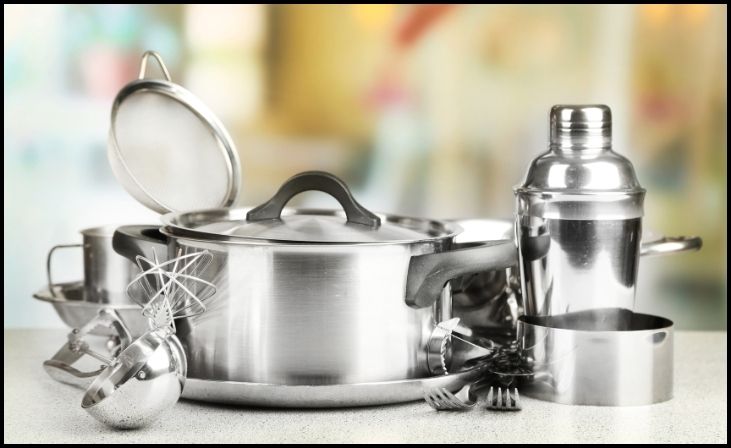
Cookware made of stainless steel is reasonably priced. It is the most adaptable material to utilize as it retains its dazzling shine and has high strength and stiffness, which prevents it from denting. It is an excellent material for any pan because stainless steel does not corrode and does not react with alkaline or acidic materials.
Stainless steel has one drawback: it does not transfer heat well. Pots and pans made of stainless steel should have a thick aluminum or copper core in the bottom to help transfer heat more uniformly and make the pan more responsive to heat to tackle this problem. The aluminum or copper core of higher-quality pans also runs up the sides.
Aluminum-core cookware is less expensive than copper-core cookware. On the other hand, copper is a somewhat better heat conductor than aluminum, which explains the price difference. In addition, copper-core pans react to temperature changes more quickly, providing the cook better control over the cooking process.
Impact-Bonded Stainless Steel
The majority of stainless steel cookware is “improved” with other metals.
The first way is impact-bonding, which involves combining an aluminum or copper base with stainless steel to improve heat transfer. For example, the conductive plate could be at the bottom of the pan or placed between stainless steel layers but not on the sides.
In other words, the cooking surface and exterior are made of stainless steel, and the base is made of aluminum or copper.
The main benefit of impact-bonded stainless steel cookware is less expensive than fully-clad stainless steel cookware. The drawback is that it does not conduct heat evenly due to the lack of an aluminum or copper covering on the cookware’s edges.
Pros
- Non-reactive.
- It’s a good buy.
- There are numerous brands to pick from.
- Lightweight.
- Heat is effectively transmitted, especially at the bottom.
Cons
- It doesn’t heat evenly on all sides.
- If not appropriately heated, it may get sticky.
- It’s a little difficult to get rid of stuck-on stains.
- Not as durable as some of the more pricey options.
- Due to the uneven heat distribution on the sides, it is not appropriate for liquids or sauces.
Care Tips
- Wash the surface lightly with soap and water. To remove stuck-on stains, fill the cookware halfway with water and bring to a boil for 15-20 minutes. Then remove them with a wooden spoon.
- Use a professional stainless steel cleaning or baking soda as an alternative.
Best For
- It’s Best for frying, browning, and searing.
- It’s unsuitable for sauces or liquids because the bottom will produce even heat. So if you’re creating a sauce, glaze, or soup, you might notice uneven heating.
Safe For
- It is safe for the oven, stovetop, and broiler.
Popular Sizes
- A 10 or 12-inch skillet would work well. Consider a three-quart saucier and a stainless stockpot or soup pot.
Best Brands
Some best Brands recommended
- Demeyere
- Calphalon
- Anolon
You might be asking if stainless steel cookware is the same as hard-anodized cookware because they both look like aluminum. While both are similar in specific ways, the former is usually more expensive and more durable.
You can choose from a variety of stainless steel cookware. Calphalon’s 10-piece set has everything you’ll need for your kitchen. However, if you want to find the best deal, the Anolon Nouvelle Stainless Steel Cookware Pots and Pans Set is a great option.
Fully-Clad Stainless Steel
Like impact-bonded base stainless steel, fully clad stainless steel is formed by bonding the metal to other conductive materials. But, on the other hand, manufacturers will go a step farther and use this metal fusion to cover the cookware, not only the bottom.
As a result, it distributes heat more uniformly and is more durable than bonded stainless steel. There are usually at least three layers (tri-ply), with one layer of stainless steel on the surface, a conductive core, and another layer of stainless steel on the outside.
Higher-quality cookware may include up to seven metal layers with a copper core rather than aluminum for better temperature distribution.
Cookware with five or even seven layers is available from some brands. The core materials vary, but the inside and exterior are always stainless steel. Therefore, the performance is affected by the number of layers and the type of core materials used.
Pros
- Excellent at distributing heat evenly and quickly.
- It will last for a long time.
- Sensitive to temperature changes.
- Multi-purpose. You can cook every recipe in fully clad stainless steel cookware.
- Adaptable to a wide range of cooktops.
Cons
- Much more expensive than stainless steel that has been partially clad.
- Food may stick to the surface.
- Good cooking skill is required.
- It may be difficult to completely clean, especially if food particles are stuck on it.
Care Tips
- Wash the surface lightly with soap and water. To remove stuck-on stains, fill the cookware halfway with water and bring to a boil for 15-20 minutes. Then remove them with a wooden spoon.
- Use a professional stainless steel cleaning or baking soda as an alternative.
Best For
- It’s ideal for almost any cooking technique or recipe, mainly browning and searing. It is ideal for steak, chicken, and other meats due to its highly conductive core and non-reactive surface.
- In addition, It can handle high temperatures; you can brown it on the stove before finishing it in the oven.
Safe For
- It’s safe for the oven, stovetop, and broiler.
Popular Sizes
- An excellent stainless-steel sauté pan with straight sides can be used for various purposes. Look for a pan with a capacity of two to six quarts.
Best Brands
The top recommended brands are
- All-Clad
- Made In
- Abbio
- Calphalon
- Viking
- Misen
As previously said, full clad stainless steel cookware is more expensive. However, I am confident that you will not be disappointed with this Heritage Steel 10-Piece Cookware Set, which features a 5-ply structure.
Cook N Home 3-Ply Clad Stainless Steel Sauce Pan; give this a try if you just want to get a feel for the material without spending too much money.
Carbon Steel
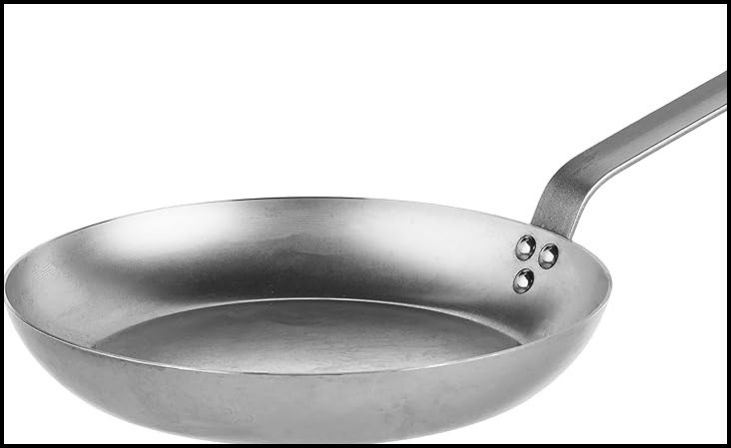
Carbon steel, like cast iron, is made up of carbon and iron. However, the iron to carbon ratio is slightly different because this substance is made up of 99 percent iron and only 1% carbon. This modification makes it lighter and easier to work with than cast iron, though it is thinner.
One of the most asked questions about carbon steel is whether it is safe to use. Because it’s made from the same component as cast iron, it’s entirely safe for use in the kitchen. You will, however, need to coat it first, much like cast iron.
Carbon steel cookware will endure a long time if properly cared for. Woks, frying and baking pans, skillets, pots, and roasters are all examples of the material.
Furthermore, many carbon steel baking pans are constructed with a layer of stick-resistant or nonstick chemicals to make cleaning easier. While frying pans are made of this metal, making them easier to maintain. For proper care, follow the manufacturer’s recommendations.
We also have Reviewed Misen carbon Steel Pan to check its longevity.
Pros
- Durability. If properly cared for, carbon steel cookware will last for a long time.
- It comes in several forms, including woks, pans, skillets, pots, and roasters.
- Lighter than the cast iron.
- Affordability.
- In response to heat, act immediately.
Cons
- Acidic foods can harm the coating.
- Discoloration and corrosion are common.
- It’s a bit challenging to clean and maintain.
- The coating is required regularly.
- Heat retention is not as good as cast iron.
Care Tips
- When cleaning carbon steel cookware, avoid using the dishwasher. Also, do not soak it in soapy water. Instead, wash this material carefully with water and soap to clean it.
- To remove stubborn stains, use a sponge or a plastic scrub. Before storing, make sure it’s completely dry and reseason.
Best For
- Almost all recipes, especially broiling, scorching, or browning. Cooks meats, omelets, veggies, stacked and normal cakes, and bread to perfection.
- Acidic foods, including tomatoes, lemon juice, and wine, will remove the seasoning. For those ingredients, use stainless steel or enameled cast iron instead.
Safe For
- Because of its great heat tolerance, it’s safe to use in the oven, cooktop, and broiler.
Popular Sizes
- Begin with a wok and a small frying pan (eight inches).
- Next, purchase a set of nice cake pans and a loaf pan for your oven.
Best Brands
Recommended brands
- Made In
- de Buyer
Merten & Storck Frying Pan is famous for home cooks. However, if you are searching for a low-cost alternative, go for BK Black Steel, a pre-seasoned carbon steel paella pan.
Copper
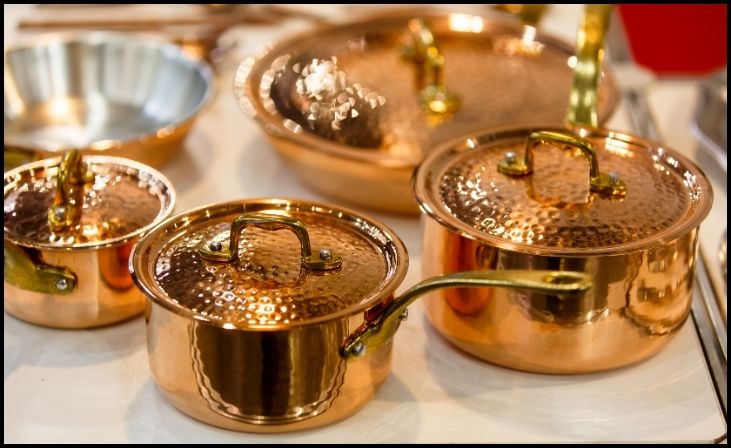
Copper is one of the most costly materials used in the production of pots and pans. It’s not only the most expensive cookware. But, it also transfers heat evenly and responds quickly to temperature changes.
It quickly heats up and cools down when away from the heat. Copper is the most crucial choice for frying and sautéing because it transmits heat evenly and efficiently, but it is also suitable for various other cooking methods.
Copper has the disadvantage of reacting to everything it comes into contact with. Moisture in the air causes a toxic layer to build on it, and salty food creates a chemical reaction that gives food a metallic flavor.
Copper pots and pans are lined with tin, silver, or stainless steel to protect any surface that may contact food. Because copper reacts to everything it comes into contact with, you must polish it regularly to maintain its bright copper shine.
While some people are confused between stainless steel and copper cookware, the ideal option is in the middle. While tin was once the most popular copper lining material, stainless steel has overtaken it in popularity because of its better durability.
Pros
- The beautiful cookware will add a splash of color to your kitchen.
- Excellent at fast and evenly distributing heat.
- Very quick to respond.
- It won’t rust.
- It’s simple to clean.
Cons
- It will react to certain types of food.
- Maintenance and polishing are required regularly.
- Expensive.
- For high-heat cooking, this is not a good option.
- It is not suitable for use on an induction cooktop.
Care Tips
- Hand-wash copper cookware in hot soapy water and avoid using abrasive cleaning materials.
- To prevent rusting and white spots on copper, use copper polish. Depending on usage, the interior should be re-tinned every couple of years.
Best For
- Simmering, frying, and sauteing are all options.
- You’ll be able to accurately manage the temperature of fish, caramel, fruit flambe, and sauce recipes once you’ve learned their use.
Safe For
- It’s ideal for the oven, stovetop, and broiler.
Popular Sizes
- A decent medium to large sautés pan and saucier is an excellent place to start.
Best Brands
Some Brands mentioned below
- Made In
- Mauviel
- Ruffoni
- Lagostina
The Lagostina Martellata Hammered Copper Cookware Set is a terrific place to start if you’re interested in copper cookware. Then, when you’re ready to invest in a more excellent piece, choose this Hestan – CopperBond Collection – 100% Pure Copper Skillet.
Aluminum
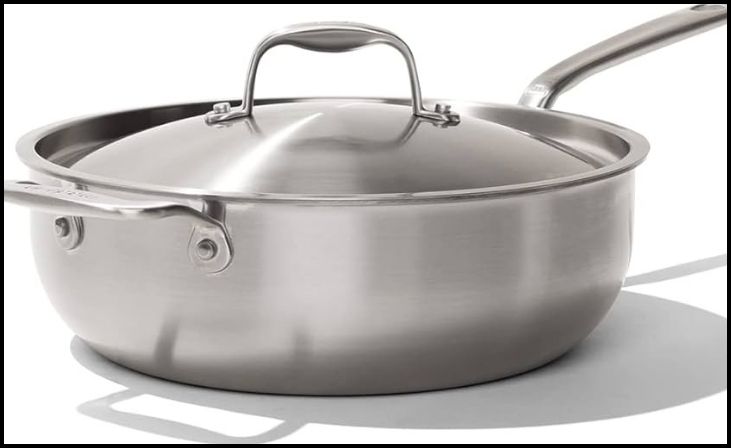
Aluminum is one of the finest heat conductors. It’s also incredibly affordable and light. However, due to its fragility and reactivity, this metal does not form suitable cookware on its own.
Manufacturers commonly use aluminum in nonstick or stainless steel cookware to take advantage of the material’s excellent conductivity. However, aluminum also produces superior bakeware when combined with other metals.
Hard-anodized aluminum, an improved version of the metal, eliminates many drawbacks that keep aluminum from being a stand-alone cookware material.
Pros
- It’s relatively inexpensive.
- Aluminum has a high heat conductivity. It can heat up quickly and evenly.
- Aluminum can be found in various cookware, including stainless steel and nonstick.
Cons
- Aluminum is not a long-lasting material. You’ll be disappointed if you expect it to last as long as cast iron.
- Acidic food causes a reaction. Your cuisine will taste metallic if you use pure aluminum.
- When subjected to high cooking temperatures, it can lose its shape.
Care Tips
- Dishwashing soap, warm water, and a sponge are all you’ll need to clean it. To remove stubborn spots, use the brittle portion of the sponge or a wooden spoon.
- Make a solution with 2-3 teaspoons of vinegar or lemon juice and 1 quart of water to remove dark spots. After that, boil the mixture for 15 minutes inside the aluminum cookware
Best For
- Aluminum cookware is ideal for veggies, stir-fries, curries, eggs, pancakes, and more as it has a nonstick coating.
- However, it’s not wise to use it for searing or browning meat or other high-heat recipes.
Safe For
- It is safe for the oven, broiler, and stovetop.
Popular Sizes
- A decent medium to large pan is an excellent place to start.
Best Brands
If you want to try it. you can check the below brands
- T-Fal
- Cuisinart
The Tramontina Professional Aluminum Nonstick Restaurant Fry Pan and Cooks Standard 12-Inch Professional Aluminum Nonstick Skillet Fry Pan are excellent value for money. Also, check out the Cuisinart Advantage Nonstick Cookware Set if you need a complete cookware set.
Hard-Anodized Aluminum

Hard-anodized aluminum is a solution to aluminum’s soft and reactive nature. It’s much more durable than pure aluminum, and because of the oxidized layer on the surface, it’s no longer sensitive to acidic foods.
A nonstick coating is frequently applied to hard-anodized aluminum cookware. Companies also use “modified” aluminum with other metals, such as fully-clad stainless steel.
Pros
- It’s much more durable than conventional aluminum.
- Non-reactive.
- It’s great for stacking because it’s scratch-resistant.
- It’s a great heat conductor.
- Thanks to the nonstick coating, there is no longer any metallic flavor.
- Can handle high temperatures.
Cons
- It’s heavier than standard aluminum.
- It can be a little costly.
- The quality varies depending on the brand.
- Some variations aren’t compatible with induction cooktops.
- In sweet baked items, this could result in over-browning.
Care Tips
- Soap and water may clean Anodized aluminum, and a plastic scrub is needed for stubborn spots.
- Most anodized metal is dishwasher safe, but double-check with the manufacturer.
- You should avoid acidic foods if the surface isn’t coated with nonstick materials or stainless steel.
Best For
- Most hard-anodized aluminum cookware is covered with a PTFE nonstick surface, making it ideal for cooking sticky foods like eggs, pancakes, and grilled cheese.
- It’s thick, long-lasting, and can sustain higher temperatures than standard aluminum. If you don’t want to use stainless steel or cast iron, you can use it for searing.
Safe For
- It is safe for the oven, stovetop, and induction burners(not always).
Popular Sizes
- Anodized aluminum pans are a less expensive option than stainless steel, so a set of frying pans may be a suitable addition to your kitchen cabinets.
Best Brands
Recommend hard-anodized aluminum:
- Calphalon
- All-Clad
- Anolon
Calphalon delivers a variety of quality hard-anodized kitchenware. The Calphalon Premier Hard-Anodized Nonstick 11-Piece Cookware Set would be a no.
Give All-Clad Hard-Anodized Nonstick Fry Pan Cookware Set a try if you just need some nice frying pans.
Nonstick (PTFE Coated)

PTFE (polytetrafluoroethylene) is a synthetic substance used to make nonstick surfaces for various cookware. The base metal of PTFE-coated cookware varies according to the brand, with anodized aluminum and fully-clad stainless steel being the most popular.
Teflon, the brand that popularized and commercialized PTFE, is now the leading manufacturer of nonstick cookware. As a result, Teflon-coated products are commonly referred to as nonstick.
While PTFE is undoubtedly inexpensive and valuable, some safety concerns have been raised recently. If you keep the cooking temperature below 500 degrees Fahrenheit, you shouldn’t have to worry about anything. However, if the nonstick coating is overheated, it may crack and release toxic gas and chemicals.
Pros
- Non-sticky.
- It’s light and inexpensive.
- Cleaning is simple.
- When paired with stainless steel, copper, or aluminum, it is a great heat conductor.
Cons
- It’s not long-lasting.
- At high temperatures, it will release harmful chemicals.
- PTFE isn’t a natural substance.
Care Tips
- You can clean PTFE-coated cookware with water, soap, and a soft sponge. Scrub gently with a plastic scrub to remove stuck-on stains. You should avoid steel wool and harsh cleaners.
- While using a dishwasher can save time, keep in mind that it can wear down the coating.
Best For
- It’s ideal for creating delicate meals like eggs, salmon, veggies, crepes, pancakes, stir-fry, curries, and crepes.
- I don’t suggest this for searing or frying meat, broiling, or grilling because high temperatures can damage the nonstick coating.
Safe For
- It’s safe to cook at temperatures below 500°F, on a cooktop, or, in some situations, in the oven.
Popular Sizes
- Start with a medium skillet, such as a 10 or 12-inch skillet. When cooking for one person, a smaller skillet can be helpful.
Best Brands
Check out the below brands:
- Scanpan
- Calphalon
- All-Clad
- T-Fal
- Made In
T-Fal Signature Nonstick Dishwasher Safe Cookware Set offers high-quality cookware at an affordable price.
Cook N Home’s 10-Piece Stainless Steel Cookware Set is another excellent value.
Nonstick (Ceramic Coated)
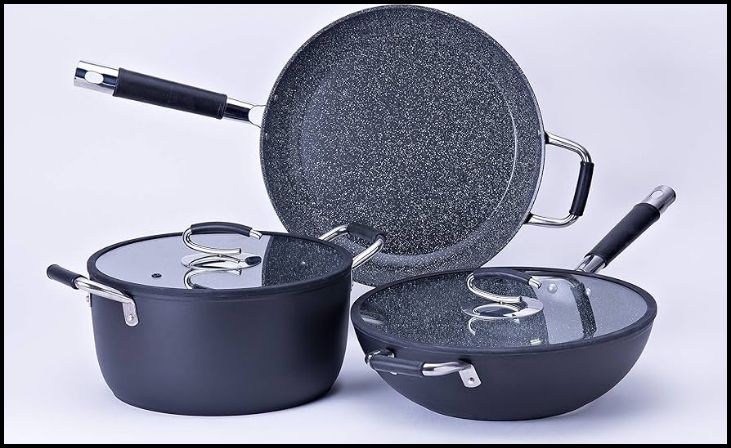
Ceramics is best to deal with if you want a cheap, dependable, and nonstick piece of cookware. In addition, ceramic is far more environmentally friendly than PTFE because it is made from natural materials.
Companies have manufactured a sand-based silicon coating that efficiently prevents food from sticking to the cookware surface using a method known as sol-gel. This coating is available in various shapes and colors.
Ceramic, like PTFE, should be kept away from high temperatures. Although it will not emit any toxic gas, it will lose its nonstick properties if exposed to too much heat.
Pros
- Non-stick.
- Non-toxic.
- Low-cost and light.
- Eco-friendly.
- It comes in a variety of styles and colors.
Cons
- It is not long-lasting.
- Scratching is a problem for you. The ceramic-like surface scratches readily, reducing the nonstick properties. To avoid this, use nylon or wooden tools.
- The heating is inconsistent and uneven.
- Browning and searing are not recommended.
Care Tips
- Give enough time for the dish to cool if it is dirty. Soak in water and soap until the residue comes out of the pan. With a plastic brush or sponge, scrub any stuck-on areas.
- The majority of ceramics can be washed in the dishwasher.
Best For
- Like PTFE-coated nonstick cookware, Ceramic cookware is excellent for light meals that stick, such as eggs, pancakes, stir fry, veggies, and other delicate, flakey dishes.
- In addition, it is safe to use in tomato, lemon, and wine sauces because it does not react with acidic foods.
Safe For
- It is safe for the oven.
Popular Sizes
- Use a medium or large casserole dish to begin. Ramekins and gratin plates are also excellent choices.
Best Brands
Some Brands are
- Caraway
- GreenPan
- Blue Diamond
Ceramic cookware is the most cost-effective method to add color to your kitchen. GreenPan Chatham Hard Anodized Ceramic Nonstick Set is available in a primary grey hue. In contrast, GreenLife Soft Grip Ceramic Nonstick Set is available in various colors, including blue, red, turquoise, and more. You can also follow our guide on cooking with ceramic pans.
Glass
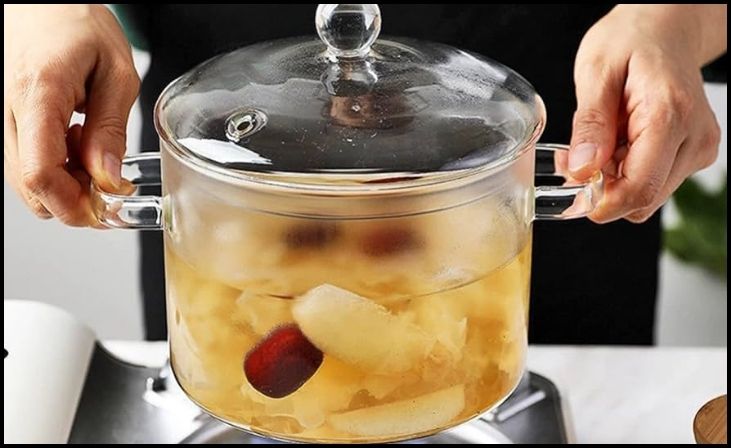
Due to its non-reactive and heat-conductive nature, glass cookware is the finest choice for baking well-brown baked items.
Glass cookware is also suitable for roasting meat and veggie dishes. Also, after you’ve finished cooking, you can preserve your food in a glass pan.
However, You should not bake sugary sweets in glass dishes since they tend to caramelize too quickly. Furthermore, broiling food in glass cookware is not recommended due to the risk of shattering from the extreme heat.
Pros
- Heat conductivity is good.
- Non-reactive.
- Inexpensive.
Cons
- Sugar may caramelize too much.
- It is not advisable to broil dishes.
Care Tips
- It’s simple to clean glass cookware. You can wash it with soap, water, sponges, or plastic scrapes as often as you like or in the dishwasher.
- All you have to remember is to allow your pans to cool completely before cleaning them.
Best For
- It’s great for baked products that need to brown nicely and roasted meats and veggies. Casseroles, cobblers, bread puddings, and pies are also possible.
Safe For
- It’s ideal for the oven.
Popular Sizes
- Any kitchen will benefit from a medium to large rectangular and a smaller square baking dish. A pie plate is also a nice touch.
Best Brands
Some brands are:
- Pyrex
- Moss and Stone
A set of Oven Safe Glass Baking Dish that is both inexpensive and efficient is a must-have for any kitchen. This 8-Pc Deep Glass Baking Dish Set with Plastic Lids, on the other hand, is a superior choice for serious bakers.
Silicone
For bakers, silicone is yet another must-have category of cookware. Baking will be considerably more manageable with a silicon mat or pan liner, both outside and inside the oven.
The liners constructed of this substance keep your pizzas, cookies, and galettes from sticking, which is a baker’s worst nightmare. In addition, silicon’s nonstick properties enable it to be used as an ideal dough rolling mat.
If you’re preparing to make mousse bombs, your faithful companions will be silicon molds and muffin pans.
This cookware has the disadvantage of being difficult to clean. To make cleaning easier, choose plain, untextured pans or molds.
Pros
- Nonstick.
- It’s fantastic for producing baked items.
- It’s simple to store.
- Dishwasher-safe.
- Inexpensive.
Cons
- Heat conductivity is poor.
- It can be difficult to clean thoroughly.
- It can be challenging to get certain foods out of the mold.
Care Tips
- Clean your silicone cookware using water, soap, and a soft sponge. It’s also dishwasher safe.
Best For
- It’s great for baked items that don’t need to brown much, such as bread, light-colored cakes, and muffins.
Safe For
- It’s safe for the oven.
Popular Sizes
- A silicone sheet pan liner is the most helpful silicone bakeware component. A 12-hole muffin pan and a pair of cake pans may also come in handy.
Best Brands
Classic Cuisine Silicone Bakeware Set should meet your basic needs. Also, try this 3 Packs Flowers Silicone non-Stick Mold if you want your foods to have more appealing shapes.
Stoneware
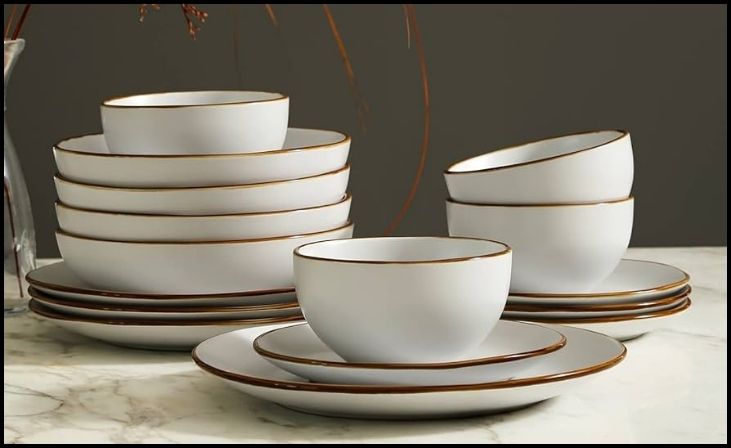
Stoneware is a material that screams vintage. Yet, despite its long history of use, it is still one of the greatest materials for producing cookware, particularly for oven baking.
When it comes to baking, many people swear only by stoneware. Of course, they improve food taste, but they also come in various forms and sizes.
Stoneware can be used for savory foods like casseroles, lasagna, pizzas, and pasta to sweet treats like bread puddings, custards, and brownies.
You can season the modernized version to create a nonstick surface, just like the iron cast. However, stoneware is lighter, non-reactive, and dishwasher safe.
Pros
- Durability.
- It’s possible to season it to make it non-sticky.
- Lighter than cast iron.
- It’s a fantastic vessel for baked meals.
- Non-toxic and non-reactive.
- It’s come in a choice of sizes and shapes.
Cons
- Specific maintenance techniques are required.
- It may contain lead.
Care Tips
- Because your cookware may require special cleaning and maintenance, following the manufacturer’s directions is recommended.
Best For
- Stoneware is the best option for baking baked products. Make sure you choose the appropriate types for your needs.
Safe For
- It’s ideal for the oven and stovetop.
Popular Sizes
- It comes in various sizes. You can try 10 and 11 inches, which suits you better.
Best Brands
Recommended popular brands are:
- Le Creuset
The Michelangelo Pots and Pans Set is an excellent place to begin your stoneware journey. Check out this lovely Le Creuset Stoneware Covered Rectangular Casserole if you’re in the market for some casseroles.
Clay (Pottery)
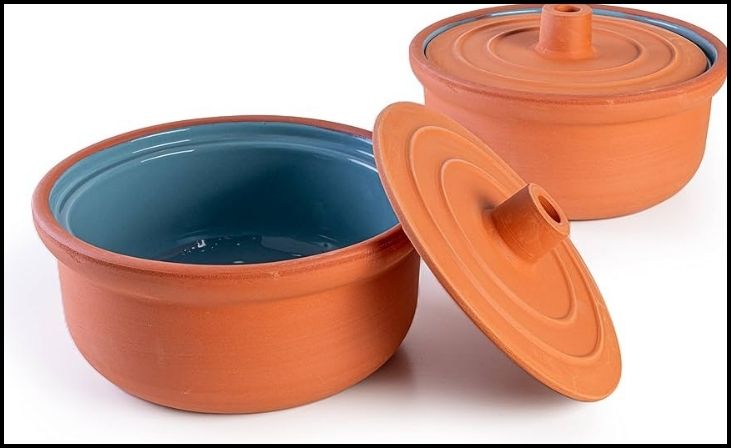
Clay cookware is non-reactive by nature and great at evenly distributing heat. They’re ideal for baking in the oven or cooking over a coal fire pit.
Many seasoned cooks say slow-cooked meals like curries and biryani taste better when cooked in earthenware. It is due to the material’s porous nature, which allows the aromatic goodness of the spices and herbs to blend better with other components.
Using clay pots provides your body with nutrients such as magnesium, iron, phosphorus, and calcium. In addition, the alkaline composition of clay will also balance the acidity in your meal, making it simpler to digest.
Nonetheless, there are several drawbacks to the material. Although earthen pots are known to survive a long time, they are prone to cracking, especially when exposed to extreme heat. Furthermore, because clay absorbs heat well, you’ll need to be careful not to burn your hand when handling it.
Pros
- Good heat conductor.
- Non-reactive.
- It neutralized acidity.
- Long-lasting.
- It should supplement essential minerals in the body.
- Versatile.
Cons
- Glazed materials can be harmful to one’s health.
- If not handled properly, it is prone to cracking.
- You may burn your hand while cooking.
Care Tips
- Cleaning them with soap or dishwashing detergent is not recommended.
- Fill them with hot water and scrub them clean with a brush instead. Then, scrub the difficult bits away with a bit of salt or baking soda in the water.
Best For
- It’s ideal for slow-cooked foods such as curries and biryani.
Safe For
- It’s perfect for cooking over an open flame, in the oven, or on the stovetop.
Popular Sizes
- It comes in various sizes. Buy according to your need.
Best Brands
Reston Lloyd has a clay pot with unglazed lit if you’re concerned about the lead content. Finally, check out Ahuonel’s Cartoon Pattern Stew Pot if you want to “trick” your child into cooking.
Glass-Ceramic
This material is a combination of ceramic and glass. Because glass is naturally nonstick, the ceramic is mainly utilized to increase the longevity and strength of the product.
Also, glass-ceramic has a low thermal expansion coefficient near zero or negative. As a result, it has better thermal shock resistance than conventional glass.
You can move glass-ceramic cookware from your freezer to your stovetop without thinking twice. However, some people might not realize that they’re actually glass because glass-ceramic is opaque or opalescent rather than translucent.
Pros
- Non-reactive.
- Impact resistance is high.
Cons
- Costly than glass cookware.
Care Tips
- Cleaning is similar to ceramic cookware.
Best For
- It’s ideal for baked products that need to brown nicely and roasted meats and veggies.
Safe For
- It is safe for the oven and stovetop.
Popular Sizes
- Try different sizes as it has various sizes.
Best Brands
Pyroflam and CorningWare products often feature this material. For instance, check out this 10-piece bakeware set and these casserole cooking pots from CorningWare.
What’s the difference between Cladding, Coating, and Anodizing?
Cookware manufacturers use various approaches to make their products perform in a specific way for the cook’s benefit. Cladding, coating, and anodizing are three of the most common construction methods.
Cladding is the technique of layering different metals in order to maximize their strengths while minimizing their weaknesses. It is possible to create a steel-clad pan with a stainless exterior and cooking surface.
You might find copper or aluminum sandwiched between the steel exterior and the core of the pan. This layering of materials provides exceptional heat conductivity from copper and aluminum. A stainless steel exterior prevents food reactivity, retains heat, and is durable.
Coating is a process that is commonly used to make nonstick pots and pans. In this procedure, a gel-like material is sprayed on top of a metal basis, which is then baked at extreme temperature to create a durable enamel shell. A “primer” layer is often applied first to promote adherence between the coating on an aluminum and stainless steel basis.
Aluminum cookware is frequently anodized, which is a chemical process. It hardens the metal’s exterior surface to increase durability, reduce food reactivity, and give nonstick characteristics.
How To Choose A Material
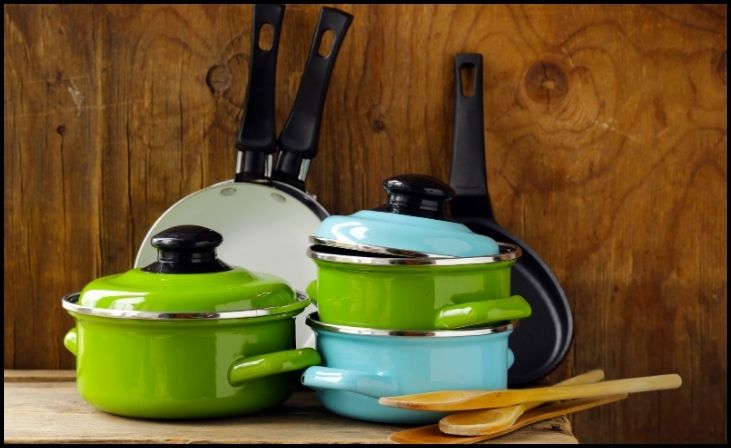
You can consider several aspects while purchasing cookware, and I don’t believe there is a one-size-fits-all solution. Instead, a well-equipped kitchen will include various cookware in size, shape, and material.
It might not make sense to have ten hefty enameled cast iron pots and pans. But, on the other hand, a single dutch oven will give a level of adaptability to your collection that no other material can match.
Nonstick cookware is the same way. A nonstick pan is fantastic for eggs, but I will use my uncoated cast iron pan to sear a steak.
Before making a purchase, the most important thing to consider is how well the cookware material fits your lifestyle. Consider what you enjoy cooking and choose the best cookware material.
Don’t be hesitant to mix and match components to suit your kitchen’s overall priorities.
Also Check: Best Cookware Set
Making The Final Decision
You probably realized that there is no absolute best cookware material; each serves a different purpose. However, here’s what you’ll need if you’re just getting started and want to know what you’ll require.
You can start with at least one nonstick pan for eggs, pancakes, grilled sandwiches, fish, and other similar dishes. I recommend something with a hard-anodized aluminum base and a PTFE nonstick coating for maximum durability. The Calphalon Contemporary line is a fantastic option. Also, Check Out Best Nonstick Frying Pans.
For searing, browning, and boiling sauces, use one stainless steel pan or skillet or one stainless steel saucepan or stockpot for boiling and sauce preparation. If you have the budget, Fully Clad is the way to go. Made In and All-Clad are two brands that I recommend. Both are pricey but well worth it.
For roasting, sautéing, braising, and frying, use a cast iron or carbon steel skillet. Both are useful, but only one is required. Remember that carbon steel is lighter than cast iron, which is heavier but better at retaining heat. Check out Made In and Misen if you’re looking for carbon steel. The lodge is one of the greatest cast iron cookware brands.
It’s good to have enameled cast iron in the kitchen, but it’s not necessary. Le Creuset is the greatest if you have the budget. Check out the enameled cast iron cookware.
If you’re seeking to buy your first complete set, stainless steel is the way to go. It’s adaptable and utilized in various cooking techniques and recipes.
After reading this article, I hope that you’ll be able to choose the perfect cookware material for your following recipe.

Leave a Reply